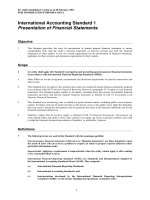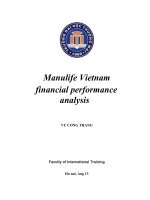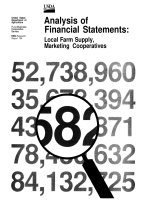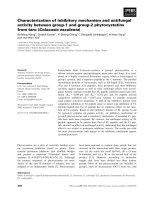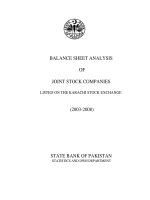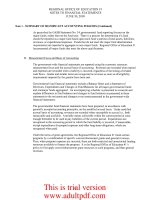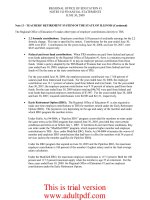Financial statements analysis group 1 HSG
Bạn đang xem bản rút gọn của tài liệu. Xem và tải ngay bản đầy đủ của tài liệu tại đây (2.39 MB, 97 trang )
HO CHI MINH UNIVERSITY OF TECHNOLOGY AND EDUCATION
COURSE: FINANCIAL MANAGEMENT
GROUP 1
ANALYSIS OF THE FINANCIAL STATEMENT
OF HOA SEN GROUP COMPANY
Instructors: Nguyễn Thị Lan Anh
MEMBERS:
STUDENT ID
Phạm Thuý Hiền
19124046
Đoàn Quang Anh
19124058
Nguyễn Hoàng Nhật Quyên
19124063
Nguyễn Thị Ánh Tuyết
19124041
Ho Chi Minh, 2021
DESCRIPTION TABLE
No
1
2
3
MISSION
Chapters 1, 3, 4.2, 4.5.3, write
comments, summarize and edit.
Section
4.5.1,
section
4.3,
writing recommendations
Section
4.5.2,
section
IMPLEMENTER
RESULTS
Phạm Thúy Hiền
100%
Nguyễn Thị Ánh Tuyết
100%
4.4, Nguyễn
writing recommendations
Hoàng
Quyên
Nhật
100%
Chapter 2, section 4.1, section
4
4.2, section 4.5.4, write the Đoàn Quang Anh
100%
conclusion.
RESULTS
…………………………………………………………………………………………
…………………………………………………………………………………………
…………………………………………………………………………………………
…………………………………………………………………………………………
…………………………………………………………………………………………
…………………………………………………………………………………………
…………………………………………………………………………………………
…………………………………………………………………………………………
…………………………………………………………………………………………
…………………………………………………………………………………………
…………………………………………………………………………………………
…………………………………………
Ho Chi Minh City, October 2021
TABLE OF CONTENTS
LIST OF ABBREVIATIONS USED ............................................................................. 1
LIST OF TABLES .......................................................................................................... 2
LIST OF GRAPHS ......................................................................................................... 2
CHAPTER 1 THEORETICAL BASIS ON ANALYSIS OF FINANCIAL
STATEMENTS IN ENTERPRISES .............................................................................. 6
1.1. Financial statements and the meaning of financial statement analysis in the
market economy ...........................................................................................................6
1.1.1. Financial report ..............................................................................................6
1.1.2. Importance of financial statement analysis in a market economy .................6
1.2. How to analyze corporate financial statements? ...................................................6
1.2.1. Comparative method ......................................................................................7
1.2.2. Exclusion method ...........................................................................................7
1.2.3. Balanced contact method ...............................................................................7
1.2.4. Dupont financial modeling method ................................................................7
1.2.5. Graph method .................................................................................................7
1.3. Content analysis of corporate financial statements ...............................................7
1.4. Organization of financial statement analysis in the enterprise ...........................10
CHAPTER 2: INTRODUCTION OF HOA SEN GROUP JOINT STOCK
COMPANY .................................................................................................................. 11
2.1 About the company ..............................................................................................11
2.2 Line of business ...................................................................................................11
CHAPTER 3: SITUATION OF ANALYSIS OF FINANCIAL STATEMENTS OF
HOA SEN GROUP CORPORATION ......................................................................... 12
3.1 Data source for analyzing financial statements of Hoa Sen Group Joint Stock
Corporation. ...............................................................................................................12
3.2. Analysis of balance sheet. ...................................................................................12
3.2.1. Analysis of asset movements. ......................................................................12
3.2.2. Analysis of capital fluctuations ....................................................................32
3.3 Analysis of business performance reports ...........................................................44
3.3.1 Horizontal analysis ........................................................................................44
3.3.2 Vertical analysis ............................................................................................54
3.4. Analyze cash flow statement ..............................................................................57
3.4.1 Net cash flows from operating activities .......................................................58
3.4.2 Net cash flows from investing activities .......................................................59
3.4.3 Net cash flows from financing activities .......................................................59
3.5 Analysis of financial indicators ...........................................................................59
3.5.1 Analysis of short-term debt solvency ............................................................64
3.5.2 Financial Leverage Indicator Analysis ..........................................................67
3.5.3. Analyze performance metrics.......................................................................69
3.5.4. Analyze profitability ratios...........................................................................73
3.5.5 Valuation indicators analysis ........................................................................77
CHAPTER 4: COMMENTS AND RECOMMENDATIONS ..................................... 80
4.1. Comment. ............................................................................................................80
4.1.1. Comment on the organization of the accounting apparatus. ........................80
4.1.2. Comment on the financial position of the company. ...................................80
4.2 Recommendations ................................................................................................82
CONCLUDE................................................................................................................. 85
LIST OF ABBREVIATIONS USED
BH : Sales
JSC : Joint Stock Company
DN : Enterprise
Service : Service
EBIT : Profit before interest and before tax
VAT : Value added
GVHB: Cost of goods sold
Board of Directors: Board of Directors
HTK : Inventory
Business results : Business results
NPAT : Profit after tax
Bank debt: Short-term debt
NV : Employee
NVL : Materials
ROA : Return on total assets
ROE : Return on equity
ROS : Return on sales
CIT: Enterprise income
Limited : Limited Liability
Fixed assets: Fixed assets
Assets: Short-term assets
XDCB : Basic construction
JSC : Joint Stock Company
1
LIST OF TABLES
Number
Table 3.1
Table name
Page
Changes in assets in the period of the first quarter of 2020 the second quarter of 2021
12
Vertical asset fluctuations from the first quarter of 2020 to
Table 3.2
Table 3.3
the second quarter of 2021
Movement of capital in the period of the first quarter of
2020 - the second quarter of 2021
24
45
The situation of vertical capital fluctuations in the period
Table 3.4
of the first quarter of 2020 - the second quarter of 2021
57
Horizontal analysis of business results for the period of the
Table 3.5
Table 3.6
Table 3.7
first quarter of 2020 - the second quarter of 2021
Longitudinal analysis of business results for the period of
the first quarter of 2020 - the second quarter of 2021
Summary of cash flow results for the period of the first
quarter of 2020 - the first quarter of 2021
59
54
57
Analysis of financial indicators of Hoa Sen Group Joint
Table 3.8
Stock Company in the period of the first quarter of 2020 -
59
the second quarter of 2021
Table 3.9
Table 3.10
Table 3.11
Financial index of Hoa Phat Group Joint Stock Company
in the first quarter of 2021
Financial index table of Vietnam Steel Corporation in the
first quarter of 2021
Industry average index table
61
62
62
LIST OF GRAPHS
Numbers
Graph name
Page
2
Change in total assets (capital source) in the period of the
Graph 3.1
first quarter of 2020 - the second quarter of 2021
17
Movements of short-term assets in the period of the first
Graph 3.2
Graph 3.3
quarter of 2020 - the second quarter of 2021
Movements of cash and cash equivalents in the period of
the first quarter of 2020 - the second quarter of 2021
18
19
Movements of short-term receivables in the period of the
Graph 3.4
first quarter of 2020 - the second quarter of 2021
20
Inventory fluctuations in the first quarter of 2020 - second
Graph 3.5
Graph 3.6
Graph 3.7
Graph 3.8
Graph 3.9
Graph 3.10
Graph 3.11
Graph 3.12
Graph 3.13
Graph 3.14
21
quarter of 2021
Movement of long-term assets in the period of the first
quarter of 2020 - the second quarter of 2021
Movements of fixed assets in the period of the first quarter
of 2020 - the second quarter of 2021
Movements of long-term unfinished assets in the period of
the first quarter of 2020 - the second quarter of 2021
Changes in asset structure in the period of the first quarter
of 2020 - the second quarter of 2021
Changes in liabilities in the period of the first quarter of
2020 - the second quarter of 2021
The situation of short-term debt fluctuations in the period
of the first quarter of 2020 - the second quarter of 2021
Changes in long-term debt in the period of the first quarter
of 2020 - the second quarter of 2021
Changes in equity in the period of the first quarter of 2020
- the second quarter of 2021
Changes in capital structure in the period of the first
quarter of 2020 - the second quarter of 2021
3
22
23
24
36
37
38
39
48
50
Graph 3.15
Graph 3.16
Graph 3.17
Graph 3.18
Graph 3.19
Changes in gross profit in the first quarter of 2020 - second
quarter of 2021
Fluctuations in net revenue for the period of the first
quarter of 2020 - the second quarter of 2021
Changes in net profit for the period of the first quarter of
2020 - the second quarter of 2021
Changes in financial income in the first quarter of 2020 second quarter of 2021
Changes in selling expenses in the period of the first
quarter of 2020 - the second quarter of 2021
51
52
53
54
54
The fluctuation of business administration expenses in the
Graph 3.20
period of the first quarter of 2020 - the second quarter of
54
2021
Graph 3.21
Fluctuations in financial income for the period of the first
quarter of 2020 - the second quarter of 2021
54
The situation of fluctuations in profit after corporate
Graph 3.22
income tax in the period of the first quarter of 2020 - the
54
second quarter of 2021
Fluctuations in short-term ratio, quick ratio and instant
Graph 3.23
ratio in the period of the first quarter of 2020 - the second
64
quarter of 2021
Graph 3.24
Graph 3.25
Graph 3.26
Fluctuations in financial leverage ratios in the period of the
first quarter of 2020 - the second quarter of 2021
Changes in inventory turnover in the period of the first
quarter of 2020 - the second quarter of 2021
Changes in receivables turnover in the period of the first
quarter of 2020 - the second quarter of 2021
67
69
71
Changes in the turnover of fixed assets and total assets in
Graph 3.27
the period of the first quarter of 2020 - the second quarter
of 2021
4
72
Graph 3.28
Graph 3.29
Graph 3.30
Volatility in ROS, ROA, ROE and basic profitability in the
period of Q1/2020 - Q2/2021
Change in earnings per share (EPS) for the period 1st
quarter of 2020 - 2nd quarter of 2021
Volatility in the market value-to-earnings (P/E) index
5
74
77
78
CHAPTER 1 THEORETICAL BASIS ON ANALYSIS OF FINANCIAL
STATEMENTS IN ENTERPRISES
1.1. Financial statements and the meaning of financial statement analysis in the
market economy
1.1.1. Financial report
Financial statements (financial statements) are a general picture reflecting the
situation of assets, capital sources, revenue, expenses, business results and financial
relationships of an enterprise (enterprise) at a point in time or period.
1.1.2. Importance of financial statement analysis in a market economy
- Financial statement analysis concepts
Analysis of financial statements of enterprises is essentially the analysis of financial
indicators on the reporting system or financial indicators that sources of information
from the reporting system in order to assess the financial position of enterprises,
providing information to all stakeholders. objects with different needs.
- The meaning of financial statement analysis in the market economy
Analysis of financial statements in enterprises shows how enterprises use financial
resources, factors of production so that there are measures to better use financial
resources and production factors to achieve efficiency. higher economic returns.
Therefore, financial statement analysis needs to be considered a regular and
important requirement for enterprises in the market economy. Analysis of financial
statements of enterprises is an effective and indispensable tool for different managers
in the market economy, such as: For business owners and business administrators, for
officials and employees, for investors, for lenders, for suppliers, for regulators.
1.2. How to analyze corporate financial statements?
Financial statement analysis method is a system of tools and measures to approach
and study events, phenomena, internal and external relationships, movements and
transformations of investment activities. financial and other activities, criteria to
assess the situation of investment activities, financial activities, business activities
and other activities of enterprises in order to make reasonable decisions.
6
1.2.1. Comparative method
Comparison is a commonly used and important method in analyzing financial
statements to study the results, volatility and volatility of the analytical criteria.
1.2.2. Exclusion method
The exclusion method is used to determine the trend and influence of each factor in
turn on the analytical criteria. According to this method, when studying the influence
of a certain factor, the influence of the remaining factors must be excluded. The
elimination method is used in the analysis in two ways: the continuous substitution
method and the difference number method
1.2.3. Balanced contact method
The basis of this approach is the quantitative balance between the two sides of
business factors and processes. Based on the balance relationships will determine the
influence of factors on the fluctuation of the indicator reflecting the object of
analysis.
1.2.4. Dupont financial modeling method
The Dupont financial modeling method aims to evaluate the interaction between
financial ratios by turning a composite indicator into a function of a series of
variables. That allows to analyze the effect of such ratios on the composite ratio.
1.2.5. Graph method
This method is used to illustrate the financial results obtained during the analysis
with charts, diagrams, etc. The graph method helps the analyst to clearly and
intuitively show the movements of the objects. research and quickly analyze and
orient financial indicators to find out the causes of the change in indicators, thereby
promptly taking measures to improve the efficiency of production and business
activities.
1.3. Content analysis of corporate financial statements
Depending on the position and purpose of using the analyst's information, the content
of financial statement analysis may not be the same between different analysis
groups, but in general, financial statement analysis in enterprises includes the main
contents. the following weaknesses:
- General analysis of financial situation
7
General analysis of the financial position to make an initial assessment of the
financial position of the enterprise. Through this work, managers can determine the
financial status and strength of the business, know the level of financial
independence as well as the financial difficulties that the business has to face,
especially in the field of finance. payment area. Thereby, managers can make
necessary decisions on investment, cooperation, joint venture, association, purchase,
sale, lending, etc.
- Financial structure analysis
Enterprise financial structure is considered from the perspective of both asset
structure, capital structure and the relationship between assets and capital. Financial
structure analysis is the consideration of the situation of capital mobilization and use
and the relationship between the mobilization situation and the capital use situation
of the enterprise. Thereby helping managers understand the situation of asset
allocation and asset financing sources, know the causes and signs affecting the
financial balance to make decisions to adjust the mobilization policy. operate and use
their own capital, ensuring enterprises have a healthy and efficient financial structure
and avoid business risks. At the same time, the content of this analysis also
contributes to reinforce the conclusions drawn when assessing the overall financial
situation.
- Analyze the situation of securing capital for business activities
To ensure sufficient capital for business activities, enterprises must have financial
measures to mobilize and form capital sources. The capital source of the enterprise is
formed from equity, borrowed capital and capital occupied in the payment process. In
essence, the process of analyzing the situation of ensuring capital for business
activities is the analysis of the financial balance of the enterprise, that is, considering
the balance relationship between the assets and the source of the enterprise's assets.
- Analysis of the situation and solvency
The situation and solvency of enterprises clearly reflect the quality of financial
activities and operational efficiency of enterprises. If financial performance is good,
solvency is high, enterprises will have less debt, less capital appropriation as well as
less capital appropriation. On the contrary, if the financial performance is poor, it will
8
lead to the insolvency of enterprises, misappropriation of mutual capital, and the
long-lasting and lingering debts of receivables and payables.
- Analyze business performance
Business efficiency is a general economic indicator that reflects the level of use of
physical and financial resources of an enterprise to achieve the highest efficiency.
Therefore, analyzing business performance is a basic content of enterprise financial
analysis, contributing to improving the competitiveness of enterprises in the market.
Through the analysis of factors affecting business performance, enterprises will help
businesses know the causes affecting business performance and profitability, thereby
taking appropriate measures to improve business efficiency.
- Analysis of enterprise value on the basis of balance sheet
According to international and regional practices, there are three main methods of
enterprise valuation: asset method, income method, and market comparison method.
Within each method there are many different calculation techniques. With the source
of the document is the financial statements, specifically the balance sheet, enterprises
can determine the value of enterprises according to the accounting books. - Financial
risk analysis
When considering financial risk, it is often necessary to consider debt payment risk
and the effect of debt structure on the return on equity of the enterprise. Analytical
criteria such as solvency criteria, profitability ratios also reflect financial risks. To
analyze the financial risks of enterprises, we can use the following criteria for
analysis:
- Analyze financial risks through indicators reflecting business performance:
Effective use of loan interest, return on capital (ROI).
- Analysis of financial risks through financial leverage: Debt ratio, financial leverage,
sensitivity of financial leverage:
- Forecasting targets on financial statements
Forecast financial statements are the basis for managers to come up with appropriate
and effective business plans to ensure the security of financial activities and improve
capital efficiency. When making forecasts, it is required that analysts have high
professional qualifications and practical experience, understanding of business
9
activities of enterprises in the current and future environment. Scientific forecasting
methods must be based on an objective basis, ensuring high reliability of forecast
indicators.
1.4. Organization of financial statement analysis in the enterprise
Organizing the analysis of financial statements in enterprises is the setting up of the
sequence of work steps to be carried out in the analysis process. In order to analyze
the financial statements of an enterprise to really promote the effect of the criteria in
the decision-making process, the analysis of financial statements must be organized
scientifically, reasonably, in accordance with the business characteristics of the
enterprise and the mechanism. activities, economic and financial management
mechanisms and suitable to the interests of each audience. Analysis of financial
statements in enterprises is usually carried out through the following stages: Analytical planning phase: This is the first and important stage that greatly affects the
quality, time and content of the work. analysis. Planning analysis includes defining
goals, building a system of analytical indicators.- Giai đoạn tiến hành phân tích:
This is the stage of implementation and implementation of the work recorded in the
plan, in fact, this is a harmonious combination of people, analytical methods, and
documents used to achieve information from the targets. built.
End stage:
This is the final stage of the analysis. In this stage, it is necessary to carry out the
following specific tasks: Write an analysis report, complete the analysis file
10
CHAPTER 2: INTRODUCTION OF HOA SEN GROUP JOINT STOCK
COMPANY
2.1 About the company
Hoa Sen Group Joint Stock Company (Hoa Sen Group), formerly known as Hoa Sen
Joint Stock Company, was established on August 8, 2001. After 17 years of
establishment and development, from a small private joint stock company with an
initial charter capital of VND 30 billion, Hoa Sen Group has risen to become a steel
and sheet metal manufacturing and trading enterprise. 1 Vietnam and a leading
exporter of steel sheet and steel in Southeast Asia. Hoa Sen Group currently owns 11
large factories and a system of more than 400 distribution - retail branches spread
across the country, Hoa Sen Group's products are exported to 75 countries and
territories worldwide. gender.
2.2 Line of business
- Producing roofing sheets of galvanized steel, zinc-aluminum alloy, galvanized
coating and other alloys
- Producing steel purlins, galvanized purlins
- Producing black steel pipes, galvanized steel pipes, galvanized steel pipes of other
alloys
- Producing galvanized wire mesh, galvanized steel wire, steel wire of all kinds
- Production of PVC ceiling panels
- Producing all kinds of building materials
- Buying and selling construction materials, production materials and consumer
goods
- Warehouse rental and freight services
- Industrial and civil construction
- Producing cold rolled steel in coils
- Leasing machinery, equipment and other tangible goods.
11
CHAPTER 3: SITUATION OF ANALYSIS OF FINANCIAL STATEMENTS OF
HOA SEN GROUP CORPORATION
3.1 Data source for analyzing financial statements of Hoa Sen Group Joint Stock
Corporation.
3.2. Analysis of balance sheet.
3.2.1. Analysis of asset movements.
The balance sheet (Appendix 1) generally reflects the total value of assets owned by the
company and the source of those assets at a given time. Therefore, analyzing the balance
sheet helps us get an overview of the company's financial position.
3.2.1.1. Horizontal analysis.
Table 3.1: Asset movement in the period of the first quarter of 2020 - the second quarter of
2021
Unit: Billion
ASSET
Quarter
and
2 (2021) Quarter
quarter
1 and
(2020)
2 (2021)
quarter
2
(2020)
Quuarter
2 (2021)
and quarter 3 (2020)
Difference
%
Difference
%
Difference
%
6,634,430
93.5
6,080,318
79.5
6,340,982
85.8
283,145
65.6
334,985
88.2
324,384
83.1
1. Money
268,030
65.7
311,851
85.6
312,033
85.7
2. Cash equivalents
15,115
64.2
23,135
149.0
12,351
46.9
(67,748)
-88.8
7,236
571.6
7,752
1,033.6
(67,748)
-88.8
7,236
571.6
7,752
1,033.6
1,670,105
126.7
1,672,522
127.1
1,491,325
99.6
1,679,115
161.6
1,690,017
164.4
1,498,999
123.0
A.
SHORT-TERM
ASSETS
I.
Cash
and
cash
equivalents
II.
Short-term
financial assets
1.
Held-to-maturity
investment
III.
Short-term
receivables
1.
receivables
Short-term
from
12
customers
2.
Prepayment
to
11,624
11.6
(2,634)
-2.3
3,408
3.1
(5,386)
-2.8
(6,624)
-3.5
(4,350)
(2.3)
(15,248)
148.2
(8,237)
47.6
(6,731)
35.8
IV. Inventory
4,730,861
110.8
4,007,485
80.2
4,403,791
95.8
1. Inventories
4,745,035
109.8
4,001,271
79.0
4,397,578
94.2
27.3
6,213
-8.6
6,213
(8.6)
18,066
1.8
58,089
6.0
113,729
12.6
32,018
28.9
16,636
13.2
9,455
7.1
(11,626)
-1.3
41,095
4.9
103,568
13.4
-68.6
359
51.0
707
198.6
-11.7
(808,032)
(8.9)
short-term sellers
3. Other short-term
receivables
4. Provision for shortterm bad debts
2.
Provision
devaluation
for
of (14,174)
inventory
V.
Other
current
assets
1. Short-term prepaid
expenses
2.
VAT
is
also
deductible
3. Taxes and other
amounts
receivable (2,324)
from the state
B.
LONG-TERM (1,390,178
ASSETS
I.
)
Long-term
receivables
1.
Other
long-term
receivables
II. Fixed assets
Tangible
(1,093,485
)
(63,767)
-27.5
(50,541)
-23.1
(41,608)
(19.8)
(63,767)
-27.5
(50,541)
-23.1
(41,608)
(19.8)
-14.2
(890,231)
-11.1
(736,472)
(9.3)
-12.5
(722,209)
-9.4
(573,431)
(7.6)
(1,183,182
)
1.
-14.4
fixed (989,730)
13
assets
- Original price
-
416,424
Accumulated (1,406,154
depreciation
)
2. Fixed assets under
finance lease
- Original price
-
(202,430)
Accumulated
depreciation
3.
Intangible
(181,871)
fixed
20,559
3.2
26.8
100.0
100.0
100.0
408,334
(1,130,543
)
(159,202)
(176,595)
17,393
3.1
281,784
2.1
20.4
(855,216)
14.7
(154,054)
(100.0)
(176,595)
(100.0)
22,541
(100.0)
100.0
100.0
100.0
(11,581)
-5.1
(8,820)
-4.0
(8,987)
(4.0)
3,000
1.1
3,000
1.1
0
0.0
(14,580)
26.8
(11,819)
20.7
(8,987)
15.0
(96,778)
-14.9
(109,438)
-16.5
9,520
1.8
in (96,778)
-14.9
(109,438)
-16.5
9,520
1.8
(528)
-2.4
(528)
-2.4
(528)
(2.4)
(528)
-2.4
(528)
-2.4
(528)
(2.4)
(45,922)
-11.8
(42,748)
-11.1
(38,944)
(10.2)
(105,529)
-31.1
(77,823)
-25.0
(63,982)
(21.5)
2. Deferred tax assets
59,607
120.2
35,075
47.3
25,038
29.7
TOTAL ASSETS
5,244,252
31.4
4,986,832
29.4
5,532,950
65.00
assets
- Original price
-
Accumulated
depreciation
III.
Long-term
unfinished assets
1.
Cost
construction
of
progress
IV.
Long-term
financial investment
1.
Held-to-maturity
investment
V. Other long-term
assets
1. Long-term prepaid
expenses
(Source: Appendix 1 – Consolidated financial statements for 2021, 2020)
14
Quarter 2 (2021) and Quuarter
2 (2021)
quarter 4 (2020)
and quarter 2 (2020)
Difference
%
Difference
%
A. SHORT-TERM ASSETS
4,708,357
52.2
4,855,708
54.7
I. Cash and cash equivalents
140,094
24.4
224,337
45.7
1. Money
129,462
23.7
223,453
49.4
2. Cash equivalents
10,632
37.9
885
2.3
II. Short-term financial assets
7,986
1,547.7
2,986
54.1
1. Held-to-maturity investment
7,986
1,547.7
2,986
54.1
III. Short-term receivables
964,223
47.6
193,424
6.9
1. Short-term receivables from customers
940,040
52.9
294,378
12.1
2. Prepayment to short-term sellers
11,609
11.6
(110,135)
(49.6)
3. Other short-term receivables
12,417
7.2
9,023
5.2
4. Provision for short-term bad debts
158
(0.6)
158
(0.6)
IV. Inventory
3,475,178
62.9
4,226,242
88.5
1. Inventories
3,496,170
62.8
4,240,684
87.9
2. Provision for devaluation of inventory
(20,991)
46.6
(14,442)
28.0
V. Other current assets
120,874
13.4
208,718
25.7
1. Short-term prepaid expenses
1,204
0.9
9,119
6.8
2. VAT is also deductible
118,611
15.7
198,539
29.3
1,060
35,333.3 1,060
35,333.3
B. LONG-TERM ASSETS
(500,954)
(5.7)
(237,196)
(2.8)
I. Long-term receivables
(16,630)
(9.0)
(7,272)
(4.1)
1. Other long-term receivables
(16,630)
(9.0)
(7,272)
(4.1)
2. Provision for long-term bad debts
(444,269)
(5.8)
(229,563)
(3.1)
II. Fixed assets
(326,141)
(4.5)
(118,270)
(1.7)
ASSET
3. Taxes and other amounts receivable
from the state
15
1. Tangible fixed assets
268,347
2.0
189,583
1.4
- Original price
(594,488)
9.8
(307,853)
4.8
- Accumulated depreciation
(112,152)
(100.0)
(108,338)
(100.0)
2. Fixed assets under finance lease
(130,467)
(100.0)
(130,467)
(100.0)
- Original price
18,315
(100.0)
22,129
(100.0)
- Accumulated depreciation
(5,975)
(2.7)
(2,955)
(1.4)
3. Intangible fixed assets
(5,974)
9.5
(2,954)
4.5
- Original price
(23,334)
(4.1)
(11,541)
(2.0)
- Accumulated depreciation
(23,334)
(4.1)
(11,541)
(2.0)
III. Long-term unfinished assets
(5,000)
(18.9)
0
0.0
1. Cost of construction in progress
(5,000)
(18.9)
0
0.0
IV. Long-term financial investment
(11,722)
(3.3)
11,180
3.4
1. Held-to-maturity investment
(38,795)
(14.2)
(15,756)
(6.3)
V. Other long-term assets
27,073
33.0
26,936
32.7
1. Long-term prepaid expenses
4,207,403
23.7
4,618,512
26.6
2. Deferred tax assets
4,708,357
52.2
4,855,708
54.7
TOTAL ASSETS
140,094
24.4
224,337
45.7
(Source: Appendix 1 – Consolidated financial statements for 2021, 2020)
16
Graph 3.1: Changes in total assets (capital) in the period of the first quarter of 2020 - the
second quarter of 2021
change in total assets
25.000
21.969
20.000
billions dong
16.725
16.983
16.436
17.762
17.351
15.000
10.000
5.000
0
Quý 1/2020 Quý 2/2020 Quý 3/2020 Quý 4/2020 Quý 1/2021 Quý 2/2021
(Source: Appendix 1 – Consolidated financial statements for 2020,2021)
According to the graph 3.1 “Changes in total assets (capital source) for the period of the
first quarter of 2020) – the second quarter of 2021, we see that the total assets of the
company from the first quarter of 2020 to the first quarter of 2021 fluctuated slightly, then
increased sharply and significantly until the second quarter of 2021.
Specifically, based on Table 3.1, "The asset volatility in the second quarter of 2021 has
increased sharply compared to the third quarter of 2020 has increased by VND 5533 billion,
ie an increase of about 33.66% compared to the fourth quarter of 2020. In addition, the
second quarter of 2020. 2021 will increase by VND 4986 billion, or about 29.36% over the
same period last year. The reason for the outstanding economic growth is that HSG has
boosted production and export business at factories across the country. This has had a strong
impact on the company's asset volatility. To better understand the company's volatility, we
go into a detailed analysis of the assets and their impact on the financial position of the
company.
Short-term assets
17
Graph 3.2: Movement of short-term assets in the period of the first quarter of 2020 - the
second
quarter
of
short-term asset volatility
16.000
13.733
14.000
billions dong
12.000
9.025
10.000
8.000
7.099
7.653
7.392
8.878
6.000
4.000
2.000
0
Quý 1/2020 Quý 2/2020 Quý 3/2020 Quý 4/2020 Quý 1/2021 Quý 2/2021
2021
(Source: Appendix 1 – Consolidated financial statements for 2020,2021)
Based on graph 3.2, we can see the slight fluctuation from the first quarter of 2020 to the
first quarter of 2020 with not much increase or decrease. However, in the second quarter of
2022, there was a remarkable growth, more specifically, in the second quarter of 2021, it
increased by about VND 6635 billion, which means that the second quarter of 2021 has
increased to 93.55% compared to the first quarter of 2020. Compared to the same period last
year, the second quarter of 2021 has increased by VND 6080 billion, an increase of about
79.45% compared to the same period last year, the second quarter of 2020. This is mainly
due to the significant increase in cash and cash equivalents. To understand why there is
volatility in short-term assets, we need to look at the factors that affect it. Current assets
changed mainly due to the following items:
18
Cash and cash equivalents.
Graph 3.3: Movements of cash and cash equivalents in the period of the first quarter of 2020
-
the
second
quarter
of
2021
Movements in cash and Cash equivalents
800
715
700
575
billions dong
600
500
432
380
390
Quý 2/2020
Quý 3/2020
400
491
300
200
100
0
Quý 1/2020
Quý 4/2020
Quý 1/2021
Quý 2/2021
(Source: Appendix 1 – Consolidated financial statements for 2020,2021)
Movements of cash and cash equivalents had slight fluctuations, not too strong from the
first quarter of 2020 to the first quarter of 2021. But by the second quarter of 2021, there
was a strong fluctuation, more specifically, cash and cash equivalents increased to nearly
VND 335 billion, accounting for 88.16% compared to the second quarter of 2020 because
the company sent a quite a large amount of money into the bank right at the time of the
second quarter of 2021. This is a not small proportion due to the change of many factors, so
the volatility of cash and cash equivalents changes continuously.
Short-term receivables.
Graph 3.4: Movements of short-term receivables in the period of the first quarter of 2020 the second quarter of 2021
FLUCTUATIONS IN SHORT-TERM RECEIVABLES
19
billions dong
(Source: Appendix 1 – Consolidated financial statements for 2021, 2020)
Based on graph 3.4 “The fluctuation of short-term receivables from the first quarter of 2020
to the second quarter of 2021, we see that short-term receivables tend to increase between
quarters. But it is worth mentioning that it is the second quarter of 2021 because it has
increased by a fairly large amount, increasing to nearly 1672 billion dong, accounting for
127.05 percent compared to the second quarter of 2020. The reason is due to the outstanding
increase of short-term receivables from customers in parallel with the provision for shortterm bad debts. However, the larger the receivables, the more capital is occupied by the
enterprise (stagnation in the payment stage), affecting the efficiency of capital use of the
enterprise. The company needs to take measures to ensure the ability to recover debts and
avoid affecting the company's finances.
In order to have more accurate conclusions about the causes and effects of short-term
receivables on the financial position of the company, we will study more closely in the
following sections.
Inventory.
Graph 3.5: Movement of inventories in the period from the first quarter of 2020 to the
second quarter of 2021
20
billions dong
Inventory volatility
(Source: Appendix 1 – Consolidated financial statements for 2021, 2020)
Through graph 3.5, we see that inventories increased slightly from the first quarter of 2020
to the first quarter of 2021, but the special thing in the second quarter of 2021 was a very
high increase of nearly 4731 billion VND, equivalent to 110.77% compared to the first
quarter of 2020. Compared to the same period last year, the second quarter of 2021 has
increased by VND 4008 billion, ie an increase of 80.27%, an impressive figure. The reason
is that enterprises import a lot of raw materials at high cost.
Because too much inventory will affect the current solvency of the business, stagnation of
capital, cost of storage and affect the quality of goods if stored for too long. But if the
inventory is too small, it will not be able to meet the future consumption demand, if there is
a sudden increase in customer demand, it will not be able to promptly meet the needs of
customers. Therefore, to solve the question of how much inventory is enough, is it
reasonable, we will look more closely in the analysis of the inventory ratio.
Other current assets.
The value of this item affects current assets as well as total assets, but fluctuations in this
item account for a small proportion and have a negligible effect, so we may not consider the
variation in this item. action of this item.
Long-term assets.
21

